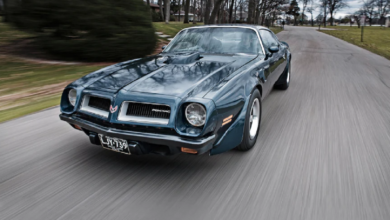Fast and Fancy: 1963 Ford Falcon Sprint
Ford had massive success with the first Ford Falcon breaking open the new compact-car market in the early Sixties. And top of the tree in ’63 was a new V8 edition: the Sprint.
Talking about American cars in the late fifties, our thoughts go to immense chrome-boats, with 19ft of swooping steel between the bumpers and bench seats, wide enough for a six-footer to get a good night’s sleep. We don’t think of frugal little compacts with thrifty six-cylinder engines and plain-Jane styling, yet that is exactly what America seemed to be crying out for.
The 1960 model year went on sale in the final months of 1959 and included Chrysler’s Valiant as a short-lived nameplate on its own (not yet badged as a Plymouth), the radical rear-engined Corvair from Chevrolet and the Falcon from Ford. Rambler trimmed the fat off its already smallish American, and Studebaker had introduced the compact Lark earlier in the year. Change was afoot.
Americans have been getting richer and rapidly we saw the emergence of the two-car family, the same time foreign carmakers started to swipe a piece of the domestic market, most notably in the form of the VW Beetle, but other small fries from Renault, Fiat, and even BMC had an effect on it too. Detroit needed something in order to satisfy the need for an inexpensive second car that could compete with the imports, thanks to the usual mixture of group-think and industrial espionage, all the major corporations created one at more or less the same time.
Ford was the winner on sales terms. The Falcon shifted a staggering 435,676 units in its first year, twice as many as the next-best-selling rival, the Corvair. That was a game-changer because everything learned in the Fifties − that more choice, more glamour, and more extravagance boosted sales – was rendered obsolete, at least at the lower end of the market.
The 1960 Falcon came with only one engine and precious few convenience options, some of those were items you might have hoped for as standard, like hubcaps, a windshield washer and a heater. A slightly larger straight-six joined the options list in 1961, but it took until 1963 for the compact Ford to become available with a V8.
You had to go up to the Futura trim level, a posher Falcon that replaced the Deluxe badge used the previous year. From half-way through the model year you could spend $2875 on a Sprint and get wire wheel covers, bucket seats and quite a lot of exterior flash with script ‘Sprint’ badges and fender logos telling everyone about the 260 V8 under the hood. It was an F-code Challenger engine lifted from the Fairlane, the Mercury Comet and other models; one of Ford’s famous small-block family. Despite the performance pretensions of the Sprint name, the Challenger V8 was in a mild state of tune, offering just 164bhp at a lazy 4400rpm via a small Holley two-barrel carb.
The vehicle gave away more than 100 bhp to the High Performance Challenger V8, that famous K-code 289cu in version that was listed as an option for larger Fords, but which would make its biggest impact in the Mustang.
But before that appearing Carroll Shelby managed to find an even more dramatic use for Ford’s small-block after he created the Cobra. Wind forward a couple of years to 1964 and Shelby tried the same thing again with the Sunbeam Alpine, creating the Tiger.
First generation Falcon Sprint cars were the basis for the 1964½ Mustangs released by Ford a year later. A lot (if not most) of the interior, chassis, suspension and drivetrain components were derived from those used on the 1963½ Ford Falcon Sprint and/or Fairlane models. In simplest terms, the 1963½ Falcon Sprint is nearly mechanically identical to the 1964½ Mustang while being aesthetically different.








